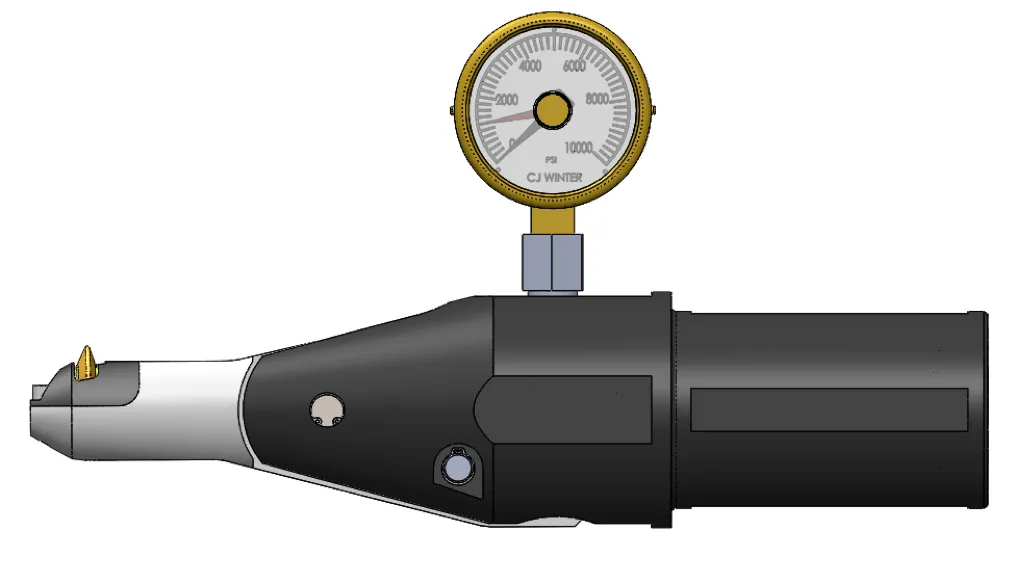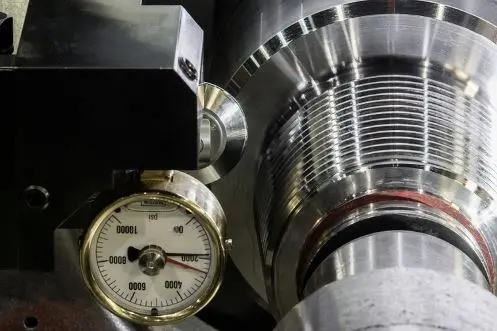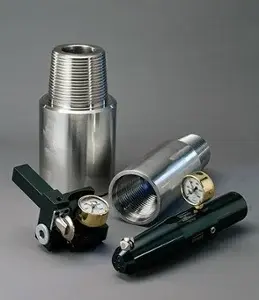What is Cold Root Rolling?
Cold root rolling is the process of burnishing the root radius of a previously cut thread, in a Rotary Shouldered Connection or thread profile. A hardened roll, similar in profile to the thread being manufactured, is placed in contact with the root radius of the tapered thread, and pressure is applied to force the roller to penetrate into the cut surface of the root radius, displacing and cold-forming the thread material. This deformation cold-works the material, imparting an improved surface finish and compacts and displaces the grains of the root material.

Industry experience with the cold root rolling process has suggested an increase in fatigue life of 3 to 5 times over similar un-treated connections under the same working environment. Some studies have noted laboratory results of up to 27 times better life attributable directly to cold root rolling process.
- API-7-1: Specification for drill stem elements.
- API 7-2: Specification for Threading and Gauging of Rotary Shouldered Connections.
- Box Connection: Internal threaded connection or I.D. thread usually manufactured as an API standard range of sizes for Rotary Shouldered Connections.
- Burnishing: Burnishing is a surface treatment performed on steel alloys to prevent stress corrosion cracking. It is a solution to reduce tensile residual stress in a material that has undergone welding or machining by providing an austenitic compressive residual stress to create a balance of residual forces. It aims to reduce the surface and near-surface residual stresses.
- Cold Forming: Cold forming is the process of forging metals at near room temperatures. In cold forming metal is formed at high speed and high pressure into tool steel or carbide dies. The cold working of the metal increases the hardness, yield, and tensile strengths.
- Cold Root Rolling: Cold root rolling is the process of burnishing the root radius of a previously cut thread, in a Rotary Shouldered Connection or thread profile. A hardened roll, similar in profile to the thread being manufactured, is placed in contact with the root radius of the tapered thread, and pressure is applied to force the roller to penetrate into the cut surface of the root radius, displacing and cold-forming the thread material. This deformation cold-works the material, imparting an improved surface finish and compacts and displaces the grains of the root material. Industry experience with the cold root rolling process has suggested an increase in fatigue life of 3 to 5 times over similar un-treated connections under the same working environment. Some studies have noted laboratory results of up to 27 times better life attributable directly to cold root rolling process.
- Cold Roll Tool: A device used to cold roll either pin / external or box / internal threaded connections. These tools are used to cold root roll threads compliant with ANSI/API 7.2:2008 and ISO 10424-2:2007, in accordance with DS-1, NS-1 specifications.
- Cold Roll Wheel / Roller: A round tool mounted on a cold rolling tool used for displacing material or burnishing the root of threads. The radius on the O.D. is supplied to match the radius in the threaded connections or meet the DS-1 specification which is slightly larger than the radius in the root of the threads. These wheels are designed for both EPL (error proof loading) systems as well as GP (general purpose) tools.
- Cold Working: Cold working is the process of strengthening metals through plastic deformation. This is made possible through the dislocation movements that are produced within a material’s crystal structure.
- Compressive Stresses: is a force that causes a material to deform to occupy a smaller volume. When a material is experiencing a compressive stress, it is said to be under compression. A high amount of compressive stress, such as tensile stress, leads to failure due to tension.
- Compressive Yield Strength: The maximum stress a metal, subjected to compression, can withstand without a predefined amount of permanent deformation.
- Depth of thread: The distance between the crest and the root of the thread, depth of thread is typically measured normal to the axis.
- Drill String Component: A drill string on a drilling rig is a column, or string, of drill pipe that transmits drilling fluid (via the mud pumps) and torque (via the kelly drive or top drive) to the drill bit. The term is loosely applied to the assembled collection of the drill pipe, drill collars, tools and drill bit.
- DS-1: Bureau Veritas established the DS-1® in 1992 to provide an industry standard for drill string inspection and design.
- EPL / Error Proof Loading: The rolls in the CJWinter tool cannot be loaded incorrectly. The EPL system uses an asymmetric hub system where the hub on one side of the roll is larger than the other. The asymmetric hubs work in conjunction with a step in the roll holder to create Step/Hub interference if the user attempts to load the roll backwards.
- Fatigue: Fatigue is the weakening of a material caused by repeatedly applied loads. It is the progressive and localized structural damage that occurs when a material is subjected to cyclic loading. The nominal maximum stress values that cause such damage may be much less than the strength of the material typically quoted as the ultimate tensile stress limit, or the yield stress limit.
- Galled: The result of the freezing of two mating surfaces of steel not protected by a film of lubricant and tearing due to lateral displacement. Can also be caused by mechanical damage of one surface.
- Last Engaged Thread, Last Scratch: The last thread on the pin engaged with the box or the box engaged with the pin.
- Lead: Lead is the distance traveled by a threading tool on a particular axis during a single-spindle revolution.
- NS-1: Quality and Inspection Requirements for New and Refurbished Drilling and Well completion equipment. NS-1™ was originally developed by Shell over a 10 year period. In order to maintain the commitment to its development as well as to release it to a larger drilling audience – it was passed over to Fearnley Procter who now has full ownership.
- Pin Connection: External threaded connection or O.D. thread usually manufactured as an API standard range of sizes for Rotary Shouldered Connections.
- Plastic Deformation: Plastic deformation is a process in which permanent deformation is caused by a sufficient load. It produces a permanent change in the shape or size of a solid body without fracture, resulting from the application of sustained stress beyond the elastic limit.
- Residual compressive stress: Residual stresses are stresses that remain in a solid material after the original cause of the stresses has been removed.
- Rotary Shouldered Connection: A connection used on drill string elements which has coarse, tapered threads and sealing shoulders.
Questions about our cold root rolling tools? Our representatives would be happy to assist you. Click here to contact us, and we’ll get back to you shortly.







